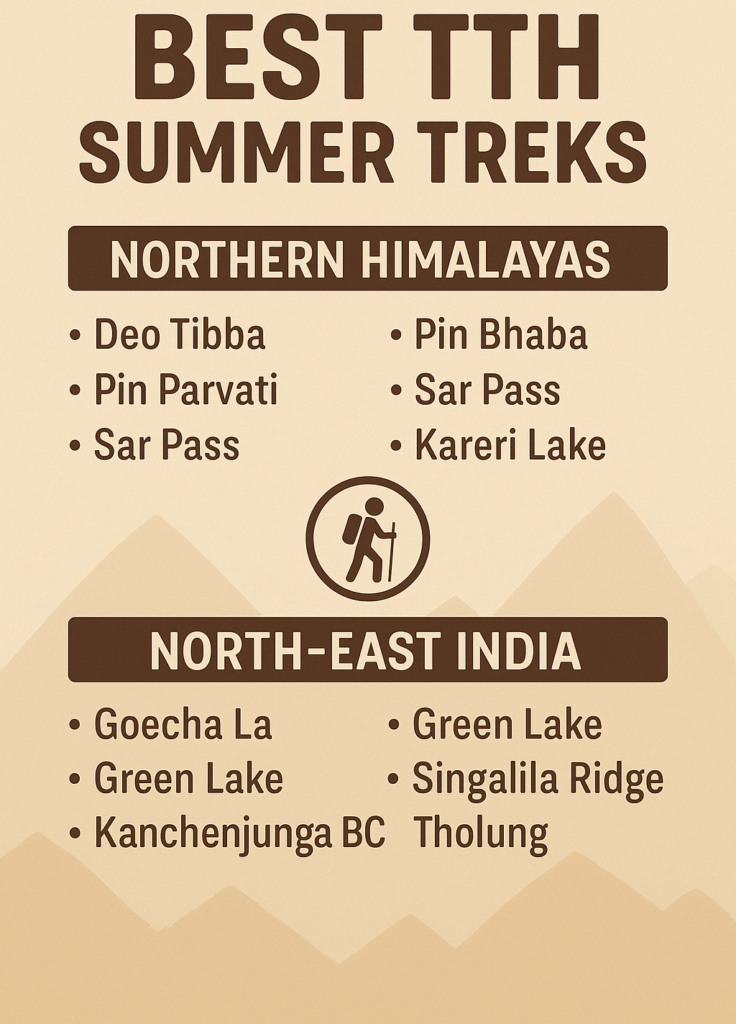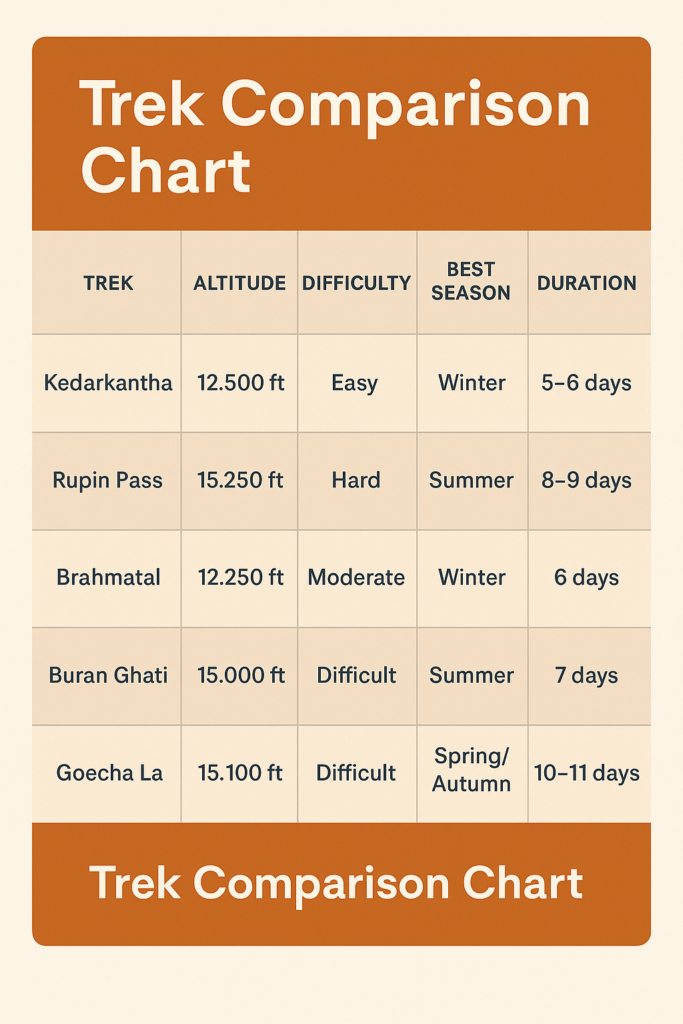Trekking in India is a tale etched in snow, whispered through pine forests, and echoed in ancient valleys. From the raw heights of the Himalayas to the mystical trails of the Western Ghats, trekking in India is not just a climb—it’s a calling.
India offers a one-of-a-kind experience—from the snow-covered Himalayas in the north to the lush green Western Ghats in the south. Every trail here is a mix of wild beauty, rich culture, and pure adventure, waiting to unfold beneath your feet.
Trekking in India is more than just walking through changing landscapes—it’s walking through centuries of culture, stories, and traditions. With every trail, from the Himalayan heights to the tropical south, you don’t just witness breathtaking views—you slowly start understanding the beauty of differences. It’s in these quiet, rugged moments that you learn not just about India, but about yourself—something that only time, silence, and the mountains can reveal.
Why Trekking in India Is More Than Just a Journey!
Trekking in India isn’t just about reaching the summit—it’s about experiencing landscapes, cultures, and lessons that stay with you long after the trail ends.
| Region | Terrain Type | Notable Treks |
| Best Himalayan Treks in North India | Snow-capped peaks & alpine meadows | Kedarkantha, Rupin Pass, Buran Ghati |
| Western Ghats Trekking Trails for Monsoon Lovers | Rainforests & rolling hills | Kudremukh, Chembra Peak |
| Unique Desert Treks in Rajasthan | Arid desert trails | Osian Desert Trail |
| Offbeat Treks in Northeast India Worth Exploring | Valleys, bamboo forests, ridges | Dzo Jongo East Peak, Goechala Trek, Bajre Dara Trek |
🌍 What Makes Trekking in India So Unique and Soulful??
Trekking in India is not just about altitude—it’s about attitude. It’s where nature, culture, and soul collide on ancient trails that have seen pilgrims, warriors, shepherds… and now you.
Walk Through Living History
You don’t just pass through villages—you walk through stories. A monastery bell in Ladakh. A shepherd’s flute in Himachal. A forgotten temple in Uttarakhand.
Every step is stitched with heritage, belief, and rhythm.
Cultural Experiences Along Indian Trekking Trails for Every Kind of Dreamer
India doesn’t offer one type of trek. It offers a mood.
- Want snow and starry nights? Try Kedarkantha.
- Love endless meadows? Go for Phulara Ridge or Dayara Bugyal.
- Crave adrenaline? Rupin Pass, Pin Bhaba, or the surreal Chadar Trek will change you.
Hospitality That Warms More Than the Campfire
In India’s mountains, strangers become family over chai.
Home-cooked meals, wooden homestays, and conversations that cross language barriers—this is mountain hospitality at its most human. Authentic Local Hospitality : Stay in rustic wooden homestays, enjoy local cuisine, and share stories by the fire. It’s not just about where you sleep—it’s about who you meet.
Day-by-Day Altitude Profiles: 5 Iconic Himalayan Treks:

Best Time to Go Trekking in India: A Seasonal Guide
🌞Summer Treks in India (May – June)
Ideal for exploring high-altitude Himalayan trails as the snow begins to melt and the landscapes burst into life.
🌧️Monsoon Treks in the Western Ghats (July – September)
Perfect time to trek the lush and misty trails of the Western Ghats, with vibrant greenery and refreshing waterfalls.
❄️Best Winter Treks in India (December – February)
Experience the magic of snow-covered Himalayan trails—ideal for classic winter treks like Kedarkantha and Brahmatal.
Trekking Tips for Beginners in India: What You Need to Know
1. Hire Local Guides
Local guides have in-depth knowledge of the terrain, weather, and culture. They not only ensure your safety but also enrich your experience with regional insights.
2. Packing Smart for Indian Treks
Carry essentials like layered clothing, a rain jacket, first aid kit, torch, and dry snacks. [Link to a comprehensive gear checklist]
3. Acclimatize for High-Altitude Treks
High-altitude trekking requires your body to adjust to lower oxygen levels. Spend a day or two at moderate altitudes before ascending and stay hydrated throughout.
4. Leave No Trace
Practice eco-friendly trekking. Carry back all waste, avoid single-use plastics, and leave the trail cleaner than you found it.
5. Stay Hydrated and Eat Well
Drink water frequently and eat energy-rich snacks to maintain stamina, especially on long or high-altitude treks.
6. Choose the Right Footwear
Invest in proper trekking shoes with ankle support and good grip. Break them in before your trek to avoid blisters.
7. Train Before You Trek
Start preparing physically at least a month in advance. Include cardio exercises, long walks, and stair climbing in your routine.
8. Research Weather and Permits
Check weather forecasts and carry all necessary permits, ID proofs, and local contact information. This is crucial for remote or protected areas.
9. Avoid Trekking Alone (Especially in the Beginning)
It’s safer and more enjoyable to trek with a group or experienced companions when you’re starting out.
10. Respect Local Culture and Nature
Be mindful of local customs, dress modestly when required, and don’t disturb wildlife or sacred places.
Trek Comparison Chart: Best Beginner Treks in India

Trekking in India: Safety, Permits & AMS Awareness
1. Trekking Permits You Need for Indian Trails
Many treks in the Indian Himalayas—especially in protected or border zones—require official permits. States like Uttarakhand, Himachal Pradesh, Sikkim, and regions in Ladakh often have restrictions in place.
Make sure to apply for permits or e-passes in advance through official portals such as:
- Uttarakhand E-Pass Portal
- Himachal Pradesh E-Pass (if required seasonally)
- Sikkim Permits
If you are trekking with a certified operator like Trek the Himalayas, permit arrangements are usually handled for you.
2. Travel Insurance for Trekking in India
Always opt for travel insurance that covers high-altitude trekking, especially for expeditions above 12,000 ft. Look for policies that include evacuation, medical emergencies, and trip cancellation~This is upto you. Just A Safety Precaution.
3. Preventing AMS on Himalayan Treks in India
AMS can occur at elevations above 8,000 ft. Learn to recognize early symptoms like headache, nausea, fatigue, and dizziness.
Must Read : https://trekthehimalayas.com/why-july-is-best-for-beginner-treks-in-india
❓ Trekking in India FAQs: Costs, Safety, and First-Time Advice
1. Is trekking in India safe?
Yes, trekking in India is generally safe, especially when done through registered and experienced trekking organizations like Trek the Himalayas (TTH). Safety protocols, trained guides, proper equipment, and medical support are provided on most organized treks. Solo trekking in remote areas should be avoided by beginners.
2. What’s the best beginner trek in India?
India offers several scenic and well-supported treks that are ideal for beginners. Some popular beginner-friendly treks organized by Trek the Himalayas include:
Kedarkantha Trek (Uttarakhand) – 12,500 ft | 20 km
A perfect winter trek with snow trails, pine forests, and panoramic summit views.
Estimated Cost: ₹6,500–₹10,000 (for 5–6 days)
Brahmatal Trek (Uttarakhand) – 12,250 ft | 24 km
A scenic winter trek with frozen lakes and views of Mt. Trishul and Nanda Ghunti.
Estimated Cost: ₹7,000–₹11,000 (for 6 days)
Dayara Bugyal Trek (Uttarakhand) – 12,100 ft | 22 km
A beautiful alpine meadow trek, great for beginners and families.
Estimated Cost: ₹7,000–₹10,000 (for 4–5 days)
These treks offer easy to moderate trails, gradual altitude gain, and full support—ideal for first-time trekkers.
3. How much does trekking in India cost?
Trekking costs vary depending on duration, altitude, and region. For well-organized group treks in the Himalayas, here’s a general cost range:
Short Treks (3–5 days): ₹5,000 – ₹10,000
Moderate Treks (6–8 days): ₹9,000 – ₹16,000
High-Altitude or Expedition-Style Treks: ₹18,000 – ₹50,000+
These costs usually include accommodation (tents/guesthouses), meals during the trek, trek leaders, safety gear, and permits. Travel to and from the base camp.
Trek Testimonials:
- 🎥 Bhrigu Lake Trek Experience – Watch the trail unfold in this Trekker Testimonial among others: https://www.youtube.com/watch?v=p6tw54n5yzA
- Chopta Chandrashila: https://www.youtube.com/watch?v=HC-l3tWnKw8
- Chandrakhani Pass : https://www.youtube.com/watch?v=tw3C6kdW9Ys
Ready to lace up your boots? Whether you’re aiming for your first summit or your next, India’s trails are waiting. Drop your questions in the comments—or share your favorite trek story!

